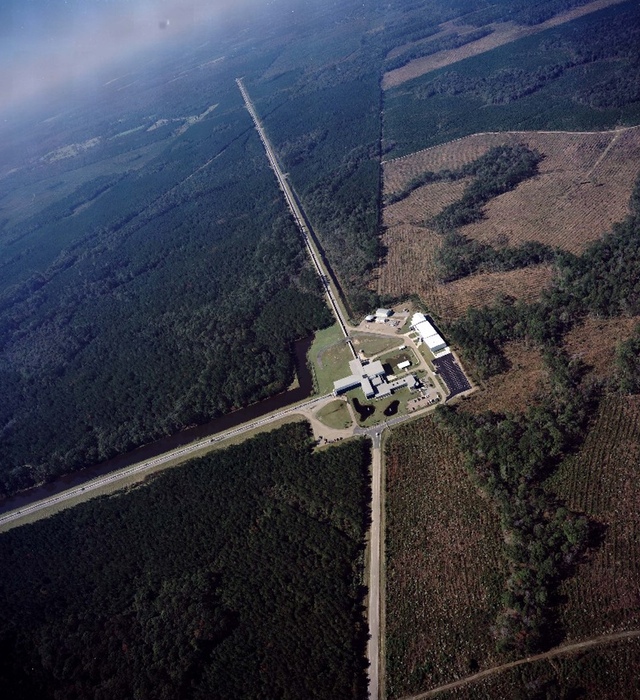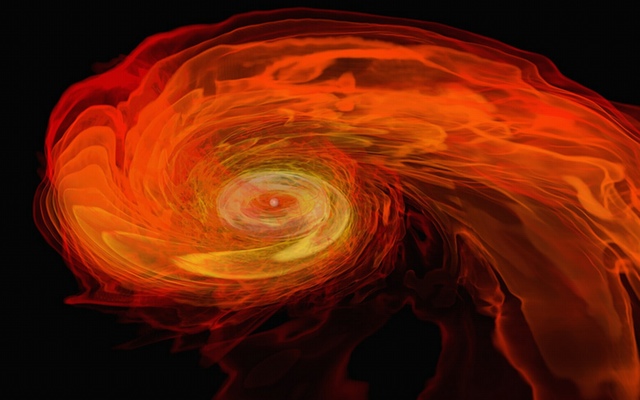Concept drawing of a neutron star merging with a black hole. Image: Dana Berry/NASA.
The direct detection of gravitational waves remains one of the most enduring white whales in cosmology. First predicted in Einstein's 1916 General Theory of Relativity, these ripples in spacetime are generated by seismic astronomical events like supernovae, galactic collisions, or even the Big Bang itself.Despite their theoretical ubiquity, gravitational waves are so subtle that detecting them remains an ongoing challenge for scientists—a reality that was highlighted this year by the BICEP2 experiment's inconclusive results.Fortunately, 2015 is shaping up to be a historic year in the hunt for gravitational waves. In fall of next year, the world's two leading gravitational wave detectors, the LIGO in Livingston, Louisiana and the Virgo in Cascina, Italy, will complete an anticipated upgrade that could finally bring the race to detect these waves to an end."LIGO and Virgo were operating previously, but are currently going through a major upgrade that makes them roughly 10 times more sensitive than their 'first generation' predecessors," astronomer Francesco Pannarale of Cardiff University told me over email."This increase in sensitivity will allow us to listen to a volume of space that is 1000 times bigger than ever before, which is why we believe we will soon be making our first direct gravitational wave detection," he said. LIGO and Virgo share the same basic design: two kilometer-long vacuum tubes arranged at a right angle like the capital letter L. Lasers located at the corner of the L shoot lasers off of reflecting mirrors located at the vertices. Passing gravitational waves should in theory warp these beams into slightly different lengths—the footprint of a gravitational wave.Unlike the overwhelming majority of astronomy, which is concerned with mining light for data, the new Advanced LIGO and Advanced Virgo facilities will behave like giant space microphones, recording the ambient sounds of distant cosmic catastrophes."The reason why we like to use the analogy with sound and microphones is that these detectors are not telescopes in the traditional sense which can be pointed in a particular direction to the sky," said Pannarale of LIGO and Virgo. "The signals we are expecting to see, or 'hear,' from coalescing black holes and neutron stars, are chirping tones in the frequency band that our ear is sensitive to.""If you put whatever LIGO/Virgo is detecting on speakers and amplify sufficiently, you can actually listen to the soundtrack of the universe," he added.We've already been lucky enough to capture the techno beats of comets and the ghostly songs of Saturn's rings, so eavesdropping on the universe's most intrinsic overtures doesn't seem farfetched at all. This delightful trippy method for capturing data is interesting on its own merits, but it also provides a springboard to studying some of the universe's most spectacular cosmic phenomena.For example, Pannarale and his colleague astronomer Frank Ohme, also of Cardiff University, hope to use LIGO and Virgo to investigate the origins of short gamma ray bursts. These extraordinarily luminous bursts of radiation last less than two seconds, differentiating them from the more common long gamma ray bursts, which are better understood by scientists.The prevailing theory is that these bursts might be caused by the merging of a neutron star with a black hole. Pannarale and Ohme recently published a paper in The Astrophysical Journal Letters outlining how LIGO and Virgo could clear up the mystery once it becomes operational next year."With our study we have shown that if a gamma-ray burst is observed by a telescope, we can take gravitational wave data at that time and look for a neutron star merging with a black hole in a faster and more efficient manner than what had been done and planned so far," Pannarale told me. "From there, researchers could confirm the origins of these short bursts, while also narrowing down the internal behavior of neutron stars.
LIGO and Virgo share the same basic design: two kilometer-long vacuum tubes arranged at a right angle like the capital letter L. Lasers located at the corner of the L shoot lasers off of reflecting mirrors located at the vertices. Passing gravitational waves should in theory warp these beams into slightly different lengths—the footprint of a gravitational wave.Unlike the overwhelming majority of astronomy, which is concerned with mining light for data, the new Advanced LIGO and Advanced Virgo facilities will behave like giant space microphones, recording the ambient sounds of distant cosmic catastrophes."The reason why we like to use the analogy with sound and microphones is that these detectors are not telescopes in the traditional sense which can be pointed in a particular direction to the sky," said Pannarale of LIGO and Virgo. "The signals we are expecting to see, or 'hear,' from coalescing black holes and neutron stars, are chirping tones in the frequency band that our ear is sensitive to.""If you put whatever LIGO/Virgo is detecting on speakers and amplify sufficiently, you can actually listen to the soundtrack of the universe," he added.We've already been lucky enough to capture the techno beats of comets and the ghostly songs of Saturn's rings, so eavesdropping on the universe's most intrinsic overtures doesn't seem farfetched at all. This delightful trippy method for capturing data is interesting on its own merits, but it also provides a springboard to studying some of the universe's most spectacular cosmic phenomena.For example, Pannarale and his colleague astronomer Frank Ohme, also of Cardiff University, hope to use LIGO and Virgo to investigate the origins of short gamma ray bursts. These extraordinarily luminous bursts of radiation last less than two seconds, differentiating them from the more common long gamma ray bursts, which are better understood by scientists.The prevailing theory is that these bursts might be caused by the merging of a neutron star with a black hole. Pannarale and Ohme recently published a paper in The Astrophysical Journal Letters outlining how LIGO and Virgo could clear up the mystery once it becomes operational next year."With our study we have shown that if a gamma-ray burst is observed by a telescope, we can take gravitational wave data at that time and look for a neutron star merging with a black hole in a faster and more efficient manner than what had been done and planned so far," Pannarale told me. "From there, researchers could confirm the origins of these short bursts, while also narrowing down the internal behavior of neutron stars. "Both points are very important in modern physics and astrophysics because we do not know for sure what generates short gamma-ray bursts and because we do not have a unique description of matter inside neutron stars, but several models for it," said Pannarale. "Our uncertainty on the exact behaviour of matter in neutron stars is due to the fact that we cannot replicate on Earth the high densities that are reached inside them."Indeed, as Pannarale pointed out, a neutron star contains the mass of roughly 1.4 times our Sun in a sphere with a diameter of about 20 kilometers. "That's about the length of Manhattan Island!" he said—a comparison that truly hits home how unfathomably dense these objects are.Delving into the nature of neutron stars and the origins of short gamma ray bursts will be two of many projects made possible by the Advanced LIGO and Advanced Virgo detectors. If everything stays on schedule, the first data from the facilities is expected in 2016.Talk about an appropriate year to make good on Einstein's 1916 prediction that gravitational waves emanate throughout the universe. A century after they were first envisioned, scientists may finally capture these elusive ripples with LIGO and Virgo, bringing us one step closer to unlocking the fundamental mechanics of the universe.
"Both points are very important in modern physics and astrophysics because we do not know for sure what generates short gamma-ray bursts and because we do not have a unique description of matter inside neutron stars, but several models for it," said Pannarale. "Our uncertainty on the exact behaviour of matter in neutron stars is due to the fact that we cannot replicate on Earth the high densities that are reached inside them."Indeed, as Pannarale pointed out, a neutron star contains the mass of roughly 1.4 times our Sun in a sphere with a diameter of about 20 kilometers. "That's about the length of Manhattan Island!" he said—a comparison that truly hits home how unfathomably dense these objects are.Delving into the nature of neutron stars and the origins of short gamma ray bursts will be two of many projects made possible by the Advanced LIGO and Advanced Virgo detectors. If everything stays on schedule, the first data from the facilities is expected in 2016.Talk about an appropriate year to make good on Einstein's 1916 prediction that gravitational waves emanate throughout the universe. A century after they were first envisioned, scientists may finally capture these elusive ripples with LIGO and Virgo, bringing us one step closer to unlocking the fundamental mechanics of the universe.
Advertisement
Advertisement
Advertisement
